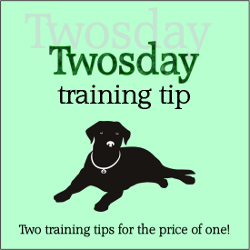 TIP #1: DO THIS, NOT THAT A replacement behavior is what you teach your dog to do instead of the problem behavior. The key to making this work is when replacement behavior becomes a more efficient or more effective way for the dog to earn the functional reward than the original problem behavior(s). Let’s take a look at an example of a dog who rushes across the room, barks, and scratches the door when you reach for your keys or his leash. If you clip on the leash and open the door to let the dog out after he does all of that, you are providing him a functional reward (the fun outing) for his behavior and you will have to repaint your door much more often. If that has happened with your dog, your best strategy is to start requiring him to sit before you clip the leash on. If the dog is bouncing around, simply set down the leash and patiently, silently refuse to clip the leash to the collar until he sits. Sitting becomes the replacement behavior for jumping and acting crazy because you have made going for a walk contingent upon polite behavior: your dog gets to go on a walk fi, and only if, he is calm. Making the functional reward of walks and car rides contingent upon sitting will quickly calm down the situation at your door. - Excerpted from Behavior Adjustment Training TIP #2: HIDE AND SEEK STRENGTHENS RECALL Hide and seek is a fun game to play in the house, in your yard, or on off-leash walks. It can be played with your dog knowing the game is afoot or as a surprise game, played at unexpected times throughout the day. It helps your dog learn to look for you when he hears your recall cue and, when played randomly, it also helps your dog learn to come when he’s otherwise engaged. To get started with the basic game, have your dog wait in one place or one room. If your dog doesn't know how to wait (or "stay"), you can also have someone restrain or distract him. Go into another room, or, if you're outside, get behind a tree or around a corner and hide. Ask your dog to "COME find me" (emphasize your cue for the recall). When your dog finds you, celebrate with a game, some happy petting, or a special treat. Repeat a few times, and stop while your dog is still really engaged. In the woods, duck behind a tree when your dog is just a little way in front. Call him enthusiastically and when he gets to you, reward him with a small handful of great treats. When your dog is hanging out at home or cruising the back yard, hide and call, "Come find me!" Reward him with a great game of tug when he finds you. Tips: When you're away from home, avoid making the hiding place too difficult. This can be stressful for your dog, and it won't be much fun. Also, time your calls for when you know your dog will easily disengage from his exploring. We do not recommend hide and seek as a way to frighten your dog into thinking you've abandoned him because he wasn't paying attention. Make this game fun, upbeat, and full of happy reconnections. - Whole Dog Journal Comments are closed.
|
AuthorJeff Dentler, CPDT-KA, IAABC-ADT, FFCP, CTDI Archives
July 2024
Categories |

 RSS Feed
RSS Feed